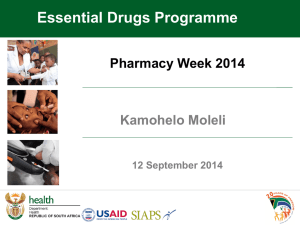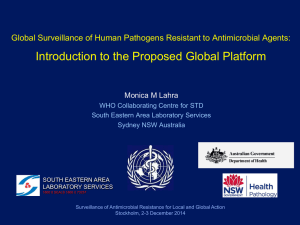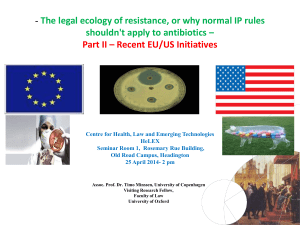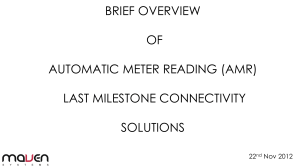SRA7-JPIAMR-PRESENTATION - Joint Programming Initiative on
advertisement
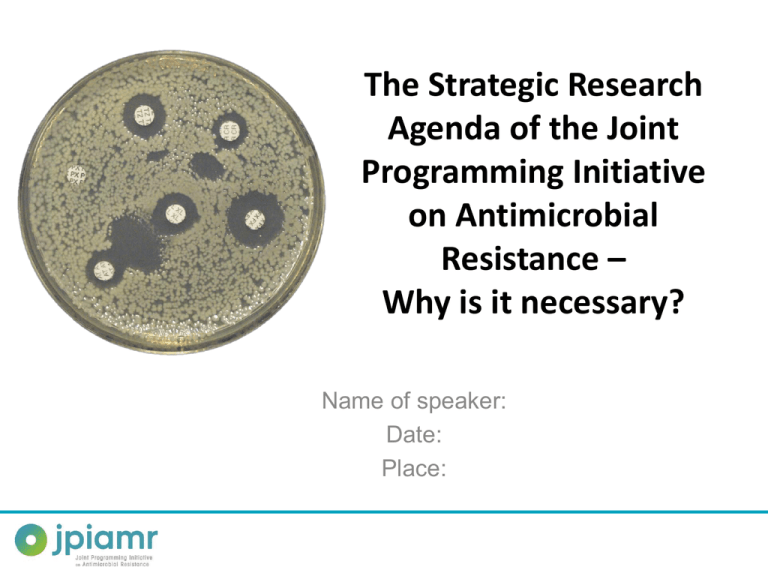
The Strategic Research Agenda of the Joint Programming Initiative on Antimicrobial Resistance – Why is it necessary? Name of speaker: Date: Place: Outline 1. The antimicrobial resistance (AMR) problem 2. Collaborating to find a solution 3. The priority topics 1. The antimicrobial resistance (AMR) problem History In his 1945 nobel prize lecture, Fleming warned of the dangers of antimicrobial resistance: “The time may come when penicillin can be bought by anyone in the shops. Then there is the danger that the ignorant man may easily underdose himself and by exposing his microbes to non-lethal quantities of the drug make them resistant.” Modern medicine depends on access to effective antibiotics Antibiotics revolutionized medicine! • The introduction of penicillin in the 1950’s increased the chance of survival for pneumonia patients from 25% to 80% Antibiotic Resistance threatens to return us to the pre-antibiotic era •In Tanzania, Antibiotic Resistance has decreased the rate of survival from neonatal gram-negative infections from 70% to 20% In the EU, more than 25 000 patients die from multidrug resistant bacteria annually (EMA/ECDC report) Extra health-care costs and productivity losses of at least 1,5 billion EURO per year What is AMR? Antimicrobial resistance (AMR) is the ability of microorganisms that cause disease to withstand attack by antimicrobial medicines. In some parts of the world, once powerful medicines against malaria and tuberculosis have now become virtually useless. AMR is rapidly becoming a major public health risk and is threatening to undo decades of advances in treating disease. Source: WHO What has led to resistance? Increased use of antibiotics Prescriptions taken incorrectly Sold without medical supervision Prophylactic use before surgery Antibiotics used for viral infection Spread of resistant microbes in hospitals due to lack of hygiene Patients who do not complete course Antibiotics in animal feeds “The more we use them, the more we lose them…” By courtesy of Dr. Liselotte Diaz Högberg Facts/context Few new drugs being developed Excessive use of antibiotics Increasing number of resistant strains Great societal costs Global problem: a societal challenge A Joint Programming Initiative is needed! The AMR complexity…… …..leads to a problem which cannot be tackled by one scientific domain or even by research alone but that needs a collaborative approach 2. Collaborating to find a solution A global problem! Worldwide spread of the 23F clone of penicillin-resistant pneumococci: U. K France Korea USA Thailand Mexico Taiwan Singapore Colombia Argentina Japan Brazil S. Africa By courtesy of Dr. Liselotte Diaz Högberg AMR research facts – National research on AMR is dispersed – No common goals – So far no success in reducing the risk of AMR The spread of AMR continues The Strategic Research Agenda (SRA): uniting under one strategy To bring together all players in the field for a multidimensional approach To provide a platform for partners to collaborate in a tailormade fashion on specific topics To harmonise joint actions and create greater impact To reduce research overlaps To create awareness and knowledge To stand a chance of actually finding a solution to the AMR problem What can be achieved by working together? (1) New preventative and therapeutic approaches AMR relevant research elements more embedded in health service and care infrastructure A reduction of inappropriate consumption of antibiotics in humans and animals What can be achieved by working together? (2) A positive impact on treatment, care and quality of life Increased visibility of the burden of AMR and the benefits of research A catalytic effect on the development on national and international strategies What exactly is the Strategic Research Agenda? The first step to drafting future research programmes A framework to begin joint actions A framework for creating an extensive transEuropean work programme on AMR 3. The priority topics SRA’s priority topics Will form a comprehensive approach for studies into strategies to reduce the use of antibiotics Will minimise the emergence and spread of antibiotic resistant genes and bacteria Will aim to reduce the burden of AMR by 2040 Six priority topics Therapeutics • Development of novel antibiotics and alternatives for antibiotics – from basic research to the market. Diagnostics • Design strategies to improve treatment and prevention of infections by developing new diagnostics. Surveillance • Standardisation and extension of surveillance systems to establish a global surveillance programme on antibiotic resistance and antibiotic use. Transmission • Transmission dynamics Environment • The role of the environment as a source for the selection and spread. Interventions • Designing and testing interventions to prevent acquisition, transmission and infection caused by AMR. Therapeutics: what’s the story? The discovery of new antibiotics has slowed in the last 40 years Even the few recently developed classes of antibiotics report resistance already Large pharma withdraw because of huge development costs Antibiotics are undervalued and underpriced Therapeutics: what the SRA aims to do Find new targets for antibiotics Develop new antibiotics Improve pharmakinetics and pharmacodynamics of neglected antibiotics What the SRA aims to do (cont’d) Develop treatment protocols based on combination therapy using existing and new antibiotics Develop alternatives for antibiotics (vaccines) Develop and study effect of policy measures and economic stimuli to minimise barriers for the development and introduction of new antibiotics Diagnostics: what’s the story? Up to 70% of antibiotics are prescribed incorrectly – Physicians cannot make precise diagnosis Diagnostic strategies can help identify patients and animals who really need antibiotics Reimbursements structures used by governments and health insurers need to allow for diagnostics What’s the story (cont’d) Diagnostic technologies exist but are costly and have not been developed with the current reality of health care in mind Behaviour change to use diagnostic technologies is needed: – clinicians, veterinarians, farmers, patients Diagnostics: what the SRA aims to do? Improve existing and develop new diagnostic tools: – that more effectively distinguish between viral and bacterial infections – that can promote the use of narrow spectrum antibiotics – for the identification of antibiotic resistance bacteria; including their resistance profile Identify and remove current barriers that inhibit the acceptance of rapid diagnostic tests Surveillance: what’s the story? Human travel and migration and the transport of food and animals enable greater spread of the genetic elements responsible for AMR Crucial surveillance data is so far lacking Countries have different levels of surveillance and many lack national reporting systems What’s the story (cont’d) Current surveillance programmes do not meet the needs of policy makers, professionals and researchers No existing international surveillance reporting system allowing for integration of data Lack of existing data on: – Morbidity and mortality – Economic costs – Associations between the emergence of resistance in humans and in animals Surveillance: why do we need it? To quantify the burden of resistance To serve as a warning system To guide policy makers To track transmission routes To detect and control localised outbreaks To document impact of interventions and efforts to reduce AMR Surveillance: what the SRA aims to do Perform operational research on the standardisation and extension of existing surveillance systems Carry out a pilot study on the feasibility of a global phenotypic and genotypic surveillance programme for AMR Initiate a surveillance programme for antibiotic use in people and animals Transmission: what’s the story? Understanding the complexity of how resistance is spread is crucial to be able to design preventative measures Transmission: what the SRA aims to do Determine by which mechanisms and how efficiently AMR can spread among bacteria that populate the human and animal intestinal tract Determine whether food is an important vector for the spread of AMR Determine the effect of migration, tourism, different health care systems and agricultural exposure of humans to antibiotics and AMR Provide testable hypothesis for intervention studies that are aimed at controlling the emergence and spread of AMR Environment: what’s the story? Environmental risk factors for the spread of resistant bacteria have not been assessed Lack of systematic analysis of food contamination, in particular in relation to environmental contamination Unclear how current practices in food production could contribute to the spread of AMR No systematic programme that addresses the impact of sewage on resistance in the environment, animals, food contamination and potable water Environment: what the SRA aims to do Perform risk assessment studies to estimate the various transmission pathways from the environment to humans Perform a meta-analysis of current national and international activities that are aimed at reducing the contamination of the environment by human and animal waste and by human activity with antibiotics and resistant bacteria What the SRA aims to do (cont’d) Determine the exact role of various environmental reservoirs (eg surface water, soild, air) on the emergence and dissemination of AMR Understand the basic biological process that underlies these phenomena to develop remediative and preventative measures Interventions: what’s the story? Little biomedical research on resistance has been translated into interventions to improve health care Most interventions to control AMR to date have been based on experience, empiricism and common sense; rather than strong evidence Lack of evidence base also in veterinary science Controlled integrated studies in society, health care and agricultural settings are urgently needed Interventions: what the SRA aims to do Initiate large-scale, international projects in which interventions to prevent and control the spread of AMR can be tested in different settings Compare and combine AMR prevention and control practices in cost efficacy trials Perform research to optimise implementation strategies of interventions aimed at reducing AMR JPIAMR anchors the priority topics By establishing a biobank of clinical specimens and strains establishing a database containing information on on-going AMR research (including veterinary and environmental samples) collaborating with stakeholders raising awareness of AMR putting focus on antibiotic resistance in bacteria that cause life-threatening infection during hospitalisation JPIAMR Participating countries (19) Belgium France Netherlands Sweden Canada Germany Norway Switzerland Czech Republic Greece Poland Turkey Denmark Finland Israel Italy Romania Spain United Kingdom SRA launch conference “Implementing a Global Research Agenda for AMR” Brussels, 3rd April 2014 Conference Objectives: Recognition and awareness for the SRA Future collaboration between research funding agencies in the field of AMR Participation of private funders Developing global funding opportunities Work towards a global Joint Programming Initiative Thank you More information at: www.jpiamr.eu

